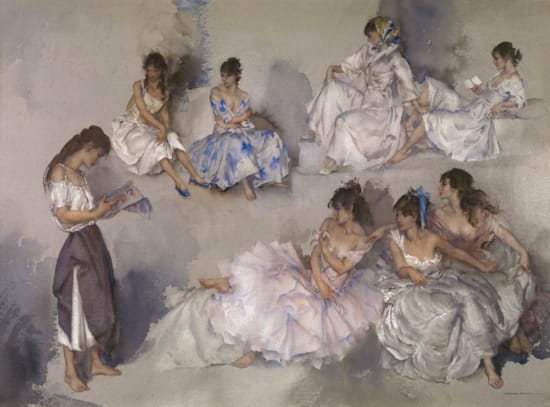Anne Redpath, OBE, RSA, ARA
(1895 - 1965)
Spring flowers
Signed, lower right: Anne Redpath
Oil on panel
24 x 19¾ in – 61 x 50.2 cm
Frame size
32¼ x 28 in – 82 x 71.1 cm
Oil on panel
24 x 19¾ in – 61 x 50.2 cm
Frame size
32¼ x 28 in – 82 x 71.1 cm
Tel.: +44 (0)20 7839 7693
Provenance
Alistair and Hazel Michie, son and daughter-in-law of the artist;
Private collection, gifted from the above, circa 1960;
Thence by descent in the family;
Private collection, USA
Private collection, gifted from the above, circa 1960;
Thence by descent in the family;
Private collection, USA
With its infusion of brilliant, white light and the specific flowers, the present work is a vibrant celebration of Spring. Much of Redpath's still life feature a bold array of colour, but her use of paler tones is an equally defining technique; as she herself said, 'I am someone who is very interested in colour - and by that I mean bright colour, gay colour; but at the same time, if you are a colourist, you like quiet colour as well and I think this love of gay colour is contrasted in my mind with this love of whites and greys.'
Employing elements of Abstract Expressionism, Redpath gives each element of the composition an equal treatment and finish, while much of the background, although boldly rendered with broad brushes, remains undefined. There is an overwhelming sense of spontaneity to the work, the impact of which is increased by the steep angle of perspective, another hallmark of Redpath's painting, which evokes a sense of the still life being propelled towards the viewer. Derek Clarke, a fellow member of the Hanover Street Group, provides an insightful description of how Redpath achieved this in practise, '...walking back and forth, turning suddenly to spring a surprise on the image and catch it unawares, screwing up her eyes to diffuse the focus and generalise the image...she was at every stage concerned with the whole of the painting rather than concentrating on a small area'.
Biography
Anne Redpath was born in Galashiels, Selkirkshire on 29th March 1895, the daughter of a Scottish Tweed designer. Redpath studied at the Edinburgh College of Art 1913-19 under Henry Lintott, and in 1919 was awarded a travelling scholarship. She visited Brussels, Bruges, Paris, Florence and Siena, and was particularly drawn to Italian 14th Century painting. On her return to Scotland in 1920 Redpath married the architect James Beattie Michie (1891-1959) with whom she moved to France, living there until 1934.
On her return to Scotland, Redpath painted principally still lifes, works showing the distinct influence of Francis Campbell Boileau Cadell (1883-1937) and that of her long held interest in textiles. Flat areas of defined colour with little modelling that also imply a familiarity with French Constructivist works. She, in addition, painted Scottish landscapes.
From the 1950’s Redpath travelled extensively and painted Mediterranean landscapes and scenes with a more colourful palette.
Redpath’s was a distinguished career, with William Gillies (1898-1973), William Crozier (1897-1930), John Maxwell (1905-62) and Sir William MacTaggart (1903-1981), she founded the Edinburgh School and was a widely respected painter.
Her first solo exhibition was held in Edinburgh in 1947. Redpath was elected to the Scottish Society of artists in 1935 and was President of the Scottish Society of Women Artists 1944-7. She was elected to the Royal Society of British Artists in 1946, the Royal Institution of Oil Painters in 1948, Associate of the Royal Scottish Academy in 1947 and an Academician in 1952, and Associate of the Royal Academy in 1960, to the Royal West of England Academy in 1958 and an Associate of the Royal Society of Painters in Watercolour in 1962. In addition, Redpath was awarded an OBE in 1955.
Her works can be found in museums in: Edinburgh, National Gallery of Modern Art and London, Tate Britain.
On her return to Scotland, Redpath painted principally still lifes, works showing the distinct influence of Francis Campbell Boileau Cadell (1883-1937) and that of her long held interest in textiles. Flat areas of defined colour with little modelling that also imply a familiarity with French Constructivist works. She, in addition, painted Scottish landscapes.
From the 1950’s Redpath travelled extensively and painted Mediterranean landscapes and scenes with a more colourful palette.
Redpath’s was a distinguished career, with William Gillies (1898-1973), William Crozier (1897-1930), John Maxwell (1905-62) and Sir William MacTaggart (1903-1981), she founded the Edinburgh School and was a widely respected painter.
Her first solo exhibition was held in Edinburgh in 1947. Redpath was elected to the Scottish Society of artists in 1935 and was President of the Scottish Society of Women Artists 1944-7. She was elected to the Royal Society of British Artists in 1946, the Royal Institution of Oil Painters in 1948, Associate of the Royal Scottish Academy in 1947 and an Academician in 1952, and Associate of the Royal Academy in 1960, to the Royal West of England Academy in 1958 and an Associate of the Royal Society of Painters in Watercolour in 1962. In addition, Redpath was awarded an OBE in 1955.
Her works can be found in museums in: Edinburgh, National Gallery of Modern Art and London, Tate Britain.




